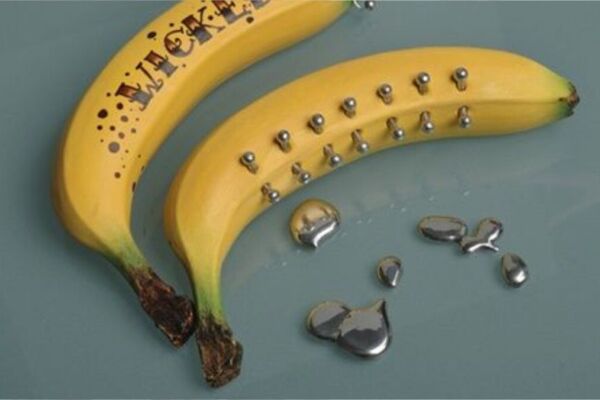The Mini Labradoodle is a cross between a Miniature Poodle and a Labrador Retriever. Bred specifically for a smaller size than the standard Labradoodle, these charming pups have captured the hearts of many with their friendly personalities, hypoallergenic coats, and manageable size.
So, why have Mini Labradoodles become such beloved companions for families and individuals alike?
What is a Mini Labradoodle?

A Mini Labradoodle is a hybrid dog breed that is a cross between a Labrador Retriever and a Miniature Poodle. This crossbreed was initially developed in the late 20th century in Australia to create a dog that possessed the intelligence, low-shedding coat and gentle temperament of the Labrador Retriever, combined with the hypoallergenic qualities of the Poodle.
The result is a charming, affectionate and highly trainable companion that is suitable for various lifestyles, including families, singles, and seniors.
ALSO READ: Micro bully: Compact companion that’s got a big heart
Origin
It all began in the late 1980s in Australia. Wally Conron, a breeder and member of the Royal Guide Dogs Association of Australia, embarked on a project to develop a hypoallergenic guide dog. He witnessed individuals who desperately needed guide dogs but were hindered by allergies to dog fur and dander.
Conron believed that crossing a Labrador Retriever, known for its gentle temperament and trainability, with a Poodle, renowned for its low-shedding coat and intelligence, could offer a solution.
The outcome was the Labradoodle, an intelligent and sociable canine possessing qualities suitable for guide dogs, alongside a coat that sheds minimally. Although this hybrid breed has not yet consistently established standard coat types or temperaments, Labradoodles are widely adored and known for their affectionate nature. In Australia, they are also known as “Cobberdogs”.
Labradoodles have seen a surge in popularity in recent years, largely attributed to the influence of social media. By 2020, they had become the 7th most popular dog breed in the United States. This rise in popularity can be attributed to their appealing blend of traits, including their hypoallergenic coat, friendly disposition, and adaptability.
Appearance
Mini Labradoodles exhibit a diverse range of appearances owing to their mixed lineage. Generally, they boast a robust physique with a square-shaped head, expressive eyes, and drooping ears. Their coat typically displays curls or waves and presents in various hues, including black, chocolate, cream, apricot, and parti-colour combinations.
The typical size range for a Miniature Labradoodle falls between 14 to 16 inches in height and 15 to 25 pounds in weight. They have a variety of coat types, but the preferred length is typically between four to six inches.
They possess a single coat with hair that ranges from straight to loose curls. Tight curls are discouraged, and the coat should not appear overly thick or fluffy.
There are three main texture types:
- The Hair coat, akin to fur found in shedding breeds, is the least favoured. Hair coats tend to shed and may carry a typical doggy odour. While common in first-generation Labradoodles, breeders often aim to avoid this type.
-
The Wool coat is dense and reminiscent of lamb’s wool, hence its name. Wool coats hang in loose curls and are not overly dense. Typically, Wool coats lack a noticeable “doggy” odour and tend to shed minimally.
-
The Fleece coat boasts a silky texture often likened to that of an Angora goat. This coat can range from straight to wavy.
They are generally considered non-oil shedders, particularly those with Fleece or Wool coats. Hair coats, however, may shed similarly to other breeds, varying from very low to moderate shedding. The Labradoodle comes in various colours, including gold, apricot, caramel, chalk (a chalky white), black, red, café, cream, silver, chocolate, parchment and blue.
Additionally, they can sport parti-coloured coats, which may include brindle, phantom, patched or sable colours. Grooming needs differ based on the length and type of coat the individual dog possesses.
Personality
The Labradoodle is an intelligent canine that, with proper training, can become an excellent addition to any family. They possess a friendly disposition and warmly embrace everyone as if they were their closest companion. Devoted to their family, they relish life as an energetic and affectionate companion.
While they can exhibit gentleness, Labradoodles are also known for their exuberant displays of joy through jumping and playfulness. Bred to be non-aggressive, they generally have an easygoing nature. However, like any breed, individual personalities may vary, but a well-trained Labradoodle with a typical temperament brings immense joy.
Temperament is influenced by various factors, such as genetics, training and socialisation. Puppies with pleasant temperaments tend to be curious, playful and readily approachable. Opting for a puppy with a balanced temperament, neither overly dominant nor excessively timid, is advisable.
Early socialisation is essential for Labradoodle puppies, involving exposure to diverse people, environments, and experiences during their formative stages.
Health
Labradoodles are generally in good health but, like all breeds, they are susceptible to certain health issues. While not all Labradoodles will develop these conditions, it is essential to be aware of them if you’re considering this mixed breed.
Here are several health concerns to keep an eye out for:
- 1. Ear infections: Labradoodles are prone to ear infections due to their floppy ears, which can trap moisture. Regular ear checks are advisable to prevent and manage this issue.
- 2. Hip dysplasia: This inherited condition occurs when the thighbone doesn’t fit properly into the hip joint. While some dogs may exhibit signs of pain and lameness, others may not show outward symptoms. X-ray screening is the most reliable method for diagnosis and dogs with hip dysplasia should not be bred.
- 3. Elbow dysplasia: Similar to hip dysplasia, this degenerative disease results from abnormal joint growth and development. It can range in severity from arthritis to lameness, and treatment options include surgery, weight management and medication.
- 4. Epilepsy: This neurological disorder can cause mild to severe seizures, often inherited but not always. Symptoms may include unusual behaviour or loss of consciousness and proper diagnosis by a vet is crucial for effective treatment.
- 5. Allergies: Labradoodles are prone to various allergies, including food, contact and inhalants. Treatment depends on the type of allergy and may involve dietary changes, medications, and environmental adjustments.
- 6. Diabetes mellitus: This disorder affects blood sugar regulation and can lead to symptoms such as increased thirst, excessive urination, weight loss, and increased appetite. Management typically involves diet control and insulin administration.
- 7. Progressive Retinal Atrophy (PRA): A group of eye diseases causing gradual retina deterioration, resulting in night blindness and eventual loss of daytime vision. Affected dogs can adapt well if their environment remains consistent.
- 8. Hypothyroidism: A thyroid gland disorder associated with various symptoms such as epilepsy, hair loss, obesity, lethargy, and skin conditions. Treatment involves medication and dietary management.
ALSO READ: Mini Aussiedoodle: Intelligent, playful breed that’s excellent pet for families
Care and exercise
Labradoodles are versatile dogs that can adapt to various environments, but they may not be the best fit for apartment living. They thrive with 30 to 60 minutes of daily exercise and benefit from a fenced yard where they can release excess energy. Some Labradoodles, especially those in the first generation, may require even more physical activity.
They make excellent jogging companions but also require off-leash time to mentally and physically stimulate them. Labradoodles are intelligent and eager to please, making training relatively straightforward with consistent methods and positive reinforcement.
They can be suitable for first-time dog owners as they respond well to gentle guidance. Early socialisation is crucial to prevent them from diving headfirst into potentially problematic situations with other dogs, especially if the other dog shows aggression.
Despite their energy levels, Labradoodles can adapt to suburban or urban environments and even rural settings. While they excel in various working roles, they are primarily companion dogs and should live indoors rather than outdoors.
Feeding
The recommended daily food intake for a Labradoodle is typically 1 to 2.5 cups of high-quality dry food, divided into two meals. However, the amount can vary depending on factors such as size, age, build, metabolism, and activity level. Just like people, dogs are individuals, and their dietary needs differ.
Naturally, a highly active dog will require more food than a less active one. The quality of the dog food you choose is crucial, as premium options provide better nutrition and may require smaller portions to satisfy the dog’s needs. To maintain the Labradoodle’s health, it’s essential to measure their food and feed them twice a day rather than leaving food available at all times.
Grooming
Typically, Labradoodles require brushing once or twice a week to maintain their coat’s condition. Some may need clipping or trimming every six to eight weeks to keep their coat manageable.
Bathing should only occur when necessary, as many Labradoodles do not have a strong doggy odour. However, like Labrador Retrievers, they can be prone to ear infections, so extra care should be taken with ear hygiene.
After swimming, ensure their ears are dry and clean, and conduct a weekly check for dirt, redness, or unpleasant odours that could indicate infection. Using a damp cotton ball with a gentle, pH-balanced ear cleaner once a week can help prevent ear problems.
Regular teeth brushing is essential to remove tartar buildup and bacteria. Aim to brush your Labradoodle’s teeth two or three times a week, or ideally daily, to prevent gum disease and bad breath. Additionally, trim their nails monthly to prevent discomfort and potential injuries.
It is best to seek advice from a vet or groomer, as cutting too far can cause bleeding and reluctance from your dog in the future.
During grooming sessions, abnormalities such as sores, rashes, or signs of infection on the skin, mouth, eyes, and feet should be checked. Clear eyes without redness or discharge are indicative of good health. Regular examinations will enable early detection of potential health issues.
How to spot a mini labradoodle

To spot a Mini Labradoodle, look for a dog with a square-shaped head, expressive eyes and floppy ears. They typically have a curly or wavy coat, which can come in various colours including black, chocolate, cream, apricot and parti-colour combinations.
Mini Labradoodles are smaller in size, usually standing between 14 to 16 inches tall and weighing between 15 to 30 pounds. They are known for their friendly and sociable nature, making them ideal family pets.
ALSO READ: Mini Goldendoodles: Dog which’s fluffiest stealers of hearts








